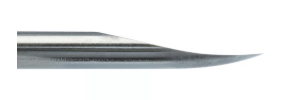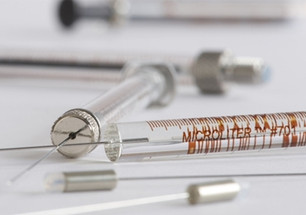Posted by Chrom Tech on 20th Nov 2025
ASK BEN | How to Choose an HPLC or GC Syringe
Syringes play a vital role in both HPLC and GC systems. For accurate analysis on a liquid or gas chromatography column, samples must be precisely introduced into the flow path—this is the syringe’s function. Chrom Tech offers an extensive selection of HPLC and GC syringes from trusted brands including Hamilton, Agilent, and Trajan SGE.
Where to Start
When selecting an HPLC or GC syringe, focus on four key parameters: syringe type, needle point style, needle gauge, and termination.
The two main syringe categories are:
- Microliter syringes — Precision liquid injections, commonly used in HPLC.
- Gastight syringes — Feature a PTFE plunger tip to prevent leaks, ideal for both GC and HPLC, especially with gaseous or volatile samples.
Choosing the Right Point Style
Needle point style affects septum penetration, clog resistance, and sample delivery. The four most common syringe needle designs are:
- Beveled – Best for GC septum piercing.
- Blunt – Ideal for HPLC injections and general liquid handling.
- Conical with side port – Minimizes clogging in headspace and viscous samples.
- Conical non-coring – Durable design for autosamplers and pre-pierced septa.
Point Style Reference Table
| Point Style | Image | Description | Common Application |
|---|---|---|---|
| 2 |  |
10–12° beveled, curved tip | Gas chromatography, septum piercing |
| 3 |  |
Blunt, electro-polished tip | HPLC injection, TLC, liquid handling |
| 5 |  |
Conical with side port | Headspace GC, clog-prone samples |
| AS |  |
Conical, non-coring, durable design | Autosampler use, pre-pierced septa |
Understanding Needle Gauge
Needle gauge defines the outer diameter (OD) of the syringe needle. Higher gauge = smaller diameter. The letter “s” (e.g., 26s) indicates a reinforced wall for improved rigidity and durability.
Common Chromatography Needle Gauges
| Gauge | OD (mm) | ID (mm) | Wall Thickness (mm) |
|---|---|---|---|
| 26s | 0.474 | 0.127 | 0.178 |
| 26 | 0.464 | 0.26 | 0.102 |
| 25s | 0.515 | 0.26 | 0.127 |
| 24 | 0.566 | 0.311 | 0.127 |
| 23s | 0.642 | 0.116 | 0.267 |
| 23 | 0.642 | 0.337 | 0.152 |
| 22s | 0.718 | 0.168 | 0.279 |
| 22 | 0.718 | 0.413 | 0.152 |
Syringe Terminations
Syringe terminations determine how the needle or fitting connects to the syringe barrel. Choose based on volume, application, and system compatibility:
- Cemented Needle: Permanent needle attachment for low-volume manual syringes.
- Removable Luer Tip: Versatile, mid-volume use; compatible with multiple needle types.
- Knurled Hub: Provides grip on modified microliter syringes for manual handling.
- Fixed Needle: Standard for CTC autosamplers and robotic injection systems.
- PTFE Luer Lock / SampleLock / Bubble-Free: Specialty designs improving sealing and reproducibility.
Frequently Asked Questions
Which syringe type should I use for my application?
Use microliter syringes for precise HPLC injections and gastight syringes for GC or mixed-phase applications. Gastight syringes provide leak-free sealing for volatile or gaseous samples.
What is the difference between microliter and gastight syringes?
Microliter syringes have metal plungers for non-volatile liquids, while gastight syringes use PTFE plunger tips to prevent leakage and handle volatile or gas samples.
How do I select the correct needle gauge?
Higher gauge = thinner needle. Most chromatography syringes use 23–26 gauge needles. An “s” suffix (e.g., 26s) indicates a stronger, thicker wall for added durability.
When should I use a beveled vs. blunt needle point?
Beveled tips are ideal for GC septum piercing, while blunt or conical needles are used for HPLC injections and general liquid handling. Side-port conical needles reduce clogging in headspace GC.
Which syringe termination fits my system?
Manual low-volume work favors cemented needles; mid-volume systems benefit from removable Luer tips; and autosamplers use fixed-needle syringes. Specialty terminations such as PTFE Luer Lock or SampleLock enhance sealing.
Where can I get expert help selecting the right syringe?
Contact Chrom Tech’s technical support at sales@chromtech.com for personalized assistance with syringe compatibility and selection.

